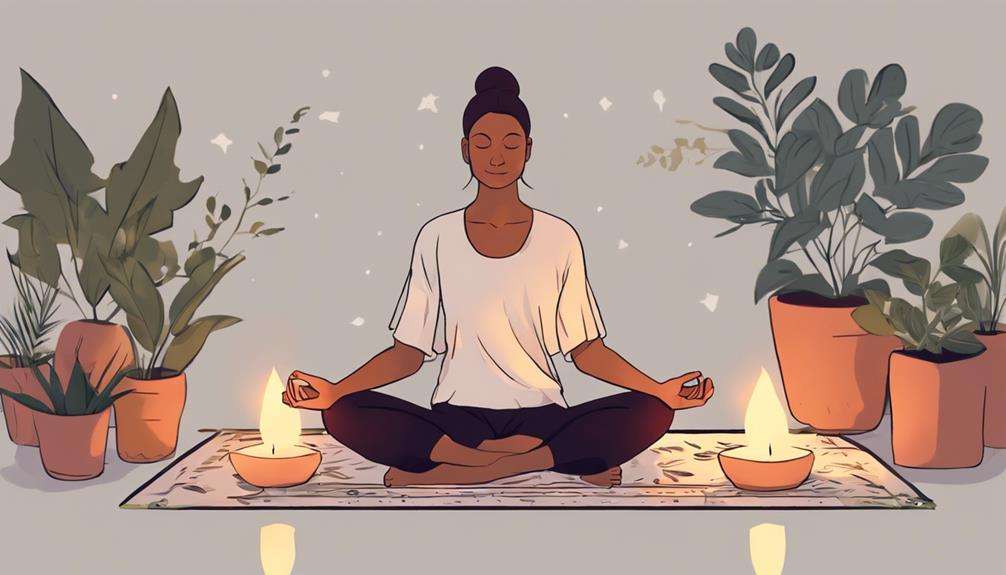You may think yoga is just about stretching and posing, but delve deeper into its practice, and you'll discover its profound impact on emotional stability.
With techniques like mindfulness, breathwork, and body awareness, yoga offers a comprehensive approach to nurturing your emotional well-being.
Each of the 7 best ways outlined can help you navigate the complexities of your emotions and build a solid foundation for a more stable and resilient inner world.
So, are you ready to explore how yoga can transform your emotional landscape?
Key Takeaways
- Engage in mindfulness practices to heighten emotional awareness and regulation.
- Use breathwork techniques like Nadi Shodhana for emotional balance.
- Practice yoga poses for emotional release and resilience building.
- Integrate mental, physical, and emotional wellbeing for peace and resilience.
Mindfulness Practices for Emotional Awareness
Engage fully in mindfulness practices during yoga to heighten your emotional awareness and foster self-compassion. Mindfulness practices in yoga offer a profound opportunity to delve into your emotional landscape with clarity and acceptance. By incorporating mindfulness techniques like body scans and mindful breathing, you can enhance your emotional regulation skills. These practices enable you to observe your thoughts and feelings without judgment, allowing for a deeper understanding of your emotional experiences.
Through mindfulness meditation during yoga sessions, you can cultivate a sense of self-compassion and learn to accept your emotions without getting entangled in them. This acceptance helps build emotional resilience, making you less reactive to triggers that may arise both on and off the mat. Regular engagement in mindfulness practices not only sharpens your emotional awareness but also equips you with the tools needed to navigate the complexities of your inner world with grace and composure.
Breathwork Techniques for Calmness
To enhance your emotional stability through yoga, explore the calming effects of breathwork techniques. By incorporating specific breathing practices like Pranayama, you can achieve a sense of calmness and mental clarity.
Here are some techniques to help you cultivate emotional balance:
- Deep Belly Breathing: Focus on deep, diaphragmatic breathing to activate the parasympathetic nervous system, which aids in relaxation and reduces stress.
- Nadi Shodhana (Alternate Nostril Breathing): This pranayama technique can restore emotional balance by harmonizing the body's energy flow, promoting a sense of peace and equilibrium.
- Mindful Breathing: Engage in mindful breathing exercises to enhance oxygen flow, improve focus, and aid in emotional regulation.
- Bhramari Pranayama (Humming Bee Breath): Practice this technique to soothe the nervous system and promote calmness, helping you find stability in your emotions.
Body Awareness for Emotional Regulation

When you practice body awareness in yoga,
you're tuning into your physical sensations and emotions,
helping you identify and manage triggers effectively.
By enhancing the body-mind connection through yoga postures,
you can skillfully respond to emotional challenges by focusing on your body sensations.
Cultivating body awareness in yoga aids in developing emotional stability
by allowing you to regulate your emotions more effectively.
Mind-Body Connection
Fostering a strong mind-body connection through yoga involves tuning into physical sensations to effectively regulate your emotions. This connection is vital for emotional stability and can be achieved through various practices within yoga:
- Enhancing Proprioception: Yoga postures help improve proprioception, allowing you to better understand your body's position in space, contributing to emotional stability.
- Embracing Mindful Movement: Engaging in mindful movement during yoga sessions creates a deeper body-mind connection, aiding in emotional regulation.
- Observing Without Judgment: Yoga encourages observing bodily sensations without judgment, fostering emotional resilience and self-regulation.
- Promoting Stress Management: Developing body awareness through yoga can lead to improved stress management and emotional well-being.
Breath Control Techniques
Enhancing your emotional stability through yoga involves mastering breath control techniques for heightened body awareness and effective regulation of your emotions.
Specific practices like Nadi Shodhana and Bhramari pranayama are key in promoting emotional balance.
Engaging in mindful breathing during yoga sessions aids in calming your mind and reducing anxiety levels.
Deep belly breathing techniques within yoga help in soothing both your body and mind, fostering a sense of peace and emotional equilibrium.
Tailoring your breathwork to match your desired emotional states is crucial for achieving effective emotional regulation through yoga.
Stress Reduction Through Yoga
When you practice yoga, you engage in mindful breathing techniques that help calm your mind and reduce stress.
The mind-body connection fostered through yoga aids in stimulating the relaxation response in your body.
Calmness Through Breathing
Cultivating emotional stability through yoga involves harnessing the power of controlled breathing techniques like Pranayama to reduce stress and promote calmness. When focusing on calmness through breathing, consider the following:
- Deep breathing techniques in yoga, such as Pranayama, can reduce stress by calming the nervous system.
- Controlled breathing patterns like Box Breathing help regulate the body's stress response for emotional stability.
- Yoga's emphasis on mindful breathing can lower cortisol levels, promoting a sense of calmness and relaxation.
- Breathing exercises like Nadi Shodhana (Alternate Nostril Breathing) can balance emotions and enhance mental clarity.
Mind-Body Connection Practice
To further deepen your understanding of emotional stability through yoga, explore the profound impact of the mind-body connection practice for stress reduction.
Yoga, with its blend of breathing exercises, postures, and meditation, fosters a strong link between your emotional and physical well-being. Regular practice can help lower stress levels by reducing cortisol, the stress hormone, promoting a calmer mental state. The mindful movements in yoga aid in releasing physical tension, alleviating emotional stress in the process.
Relaxation Response Stimulation
Stimulating the relaxation response through yoga practices is key to reducing stress and promoting emotional stability. Regular yoga practice helps reduce stress and promotes emotional balance by activating the parasympathetic nervous system.
Here are four ways yoga for emotional balance helps us combat emotional challenges and foster overall health:
- Deep breathing and gentle movements calm the body and mind.
- Lower cortisol levels lead to a sense of relaxation and emotional balance.
- Mindful practices like meditation enhance resilience to stressors.
- Improved emotional regulation and a greater sense of calmness in daily life.
Cultivating Self-Compassion and Acceptance
Practicing self-compassion in yoga involves treating yourself with kindness and understanding during challenging moments. By embracing self-acceptance in yoga practices, you can learn to accept your flaws and imperfections without judgment.
Forgiveness and letting go of self-criticism are key elements that yoga encourages to foster a sense of self-compassion. Through mindful awareness during yoga sessions, you can acknowledge your emotions with self-compassion and non-judgmental acceptance.
Cultivating self-compassion in yoga also involves recognizing the common humanity shared by all, understanding that everyone faces struggles and challenges. These practices not only contribute to emotional stability but also help in developing a more compassionate and accepting relationship with yourself.
Enhancing Mood With Yoga Poses

Enhancing your mood with specific yoga poses can be a powerful way to release emotional tension and foster emotional clarity. When practicing yoga to uplift your spirits, consider the following:
- Half Pigeon and Camel Poses: These poses aid in releasing stored emotional tension, allowing you to let go of negativity.
- Warrior 2 and Humble Warrior Poses: Balancing effort and surrender in these poses empowers emotional clarity, helping you find a sense of purpose and direction.
- Reclined Spinal Twist: This pose facilitates emotional release by cleansing both your body and mind, leaving you feeling lighter and more at ease.
- Targeting Specific Areas: By focusing on specific areas of the body, such as the hips or chest, these poses support emotional balance and stability, promoting overall well-being.
Building Resilience and Inner Strength
Yoga consistently nurtures emotional resilience and inner strength by transforming how you respond to life's challenges. Through yoga's holistic nature, which integrates mental, physical, and emotional wellbeing, you learn to cultivate emotional resilience and inner peace.
By practicing mindful breathing techniques during yoga sessions, you develop the ability to remain calm and balanced in the face of adversity. The postures and movements in yoga not only promote physical and mental strength but also aid in achieving emotional stability over time.
Regular practice of yoga enables you to respond differently to stressors, enhancing your capacity to bounce back from difficult situations with newfound strength. This shift in response helps build inner resilience, allowing you to navigate life's ups and downs with grace and stability.
The transformative power of yoga lies in its ability to foster inner strength and emotional stability, providing you with the tools to cultivate a sense of peace and resilience in the face of life's challenges.
Frequently Asked Questions
How Yoga Helps in Emotional Stability?
Yoga helps in emotional stability by relieving stress, enhancing mood, boosting resilience, reducing anxiety, and fostering self-awareness. It connects mind and body, balances emotions, and cultivates inner peace. Through yoga, you build emotional intelligence and heal energetically.
What Are 5 Mental Emotional Benefits of Yoga?
Yoga benefits your mental and emotional well-being by managing stress, enhancing self-awareness, strengthening mind-body connection, relieving anxiety, and uplifting mood. It empowers you to find emotional balance, build resilience, experience inner peace, and engage in emotional healing.
How Can We Make Our Emotion Positive With Yoga?
To make your emotions positive with yoga, focus on the mind-body connection. Use stress relief techniques, like mindful breathing. Enhance emotional balance by balancing energy flow. Cultivate a positive mindset, inner peace, and self-awareness through relaxation practices for emotional resilience and mood enhancement.
How Does Yoga Help With Emotional Regulation?
Yoga enhances emotional regulation through the mind-body connection. Breathing techniques trigger the relaxation response, reducing stress and promoting self-awareness. This balance fosters emotional stability, regulates mood, and provides mental clarity, equipping you with coping skills for inner peace.
Conclusion
In conclusion, practicing yoga is like hitting the emotional reset button for your mind, body, and soul. By incorporating mindfulness, breathwork, and yoga poses into your routine, you can cultivate a sense of emotional stability that will help you navigate life's ups and downs with ease.
So grab your mat, strike a pose, and let yoga be your secret weapon in the battle against stress and negativity. It's time to namaste your way to inner peace and happiness.






